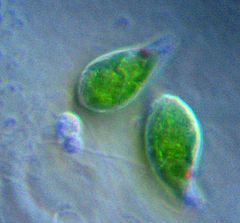Euglenozoa facts for kids
The Euglenozoa are tiny, single-celled living things. You can only see them with a microscope. Most are very small, about 15 to 40 µm long. Some can grow a bit bigger, up to 500 µm. There are two main groups of Euglenozoa: the euglenids and the kinetoplastids.
Quick facts for kids Euglenozoa |
|
|---|---|
 |
|
| Euglena | |
| Scientific classification | |
| Domain: | |
| Kingdom: | |
| Phylum: |
Euglenozoa
|
| Class: |
Euglenoidea
Kinetoplastea |
Contents
How Euglenozoa Live
Many euglenozoa are like plants because they can make their own food. This is called being autotrophic. They have special parts called chloroplasts. These chloroplasts help them get energy from sunlight through a process called photosynthesis.
However, other euglenozoa are more like animals. They are heterotrophic, which means they cannot make their own food. These types usually eat tiny things like bacteria. A few of them are parasites, meaning they live on or in another living thing and get food from it.
Euglenozoa can also move on their own, just like animals. They are mobile. They use a whip-like tail called a flagellum to push themselves through water.
Reproduction
Unlike animals, euglenozoa reproduce in a simple way. They only make more of themselves by dividing. This process is called mitosis. When a euglenozoa cell divides, it usually makes 4 to 8 new cells. Each new cell gets its own flagellum.
How Scientists Group Euglenozoa
Most scientists think that all euglenozoa came from one common ancestor. This idea is called being monophyletic. They are also related to another group of tiny living things called the Percolozoa. Some scientists believe that euglenozoa and percolozoa are part of a larger group of eukaryotes called the Excavata.
The biggest difference between euglenids and kinetoplastids is how they make food. Euglenids have plastids (like chloroplasts) that help them make food. Kinetoplastids do not have these plastids.
Cool Facts About Euglenozoa
- Euglenozoa have features of both plants and animals.
- Most euglenozoa have two flagella, even though they mainly use one to move.
- Euglenids can live in both fresh water and salt water.
- Because they have chloroplasts, many euglena are a bright green color.
- Euglena's chloroplasts are special. They have three membranes around them, while plant chloroplasts only have two.
- Some Kinetoplastids can make people or animals sick.
- Many kinetoplastids live on decaying things, like rotting plants or other organic matter.
See also
 In Spanish: Euglenozoa para niños
In Spanish: Euglenozoa para niños

